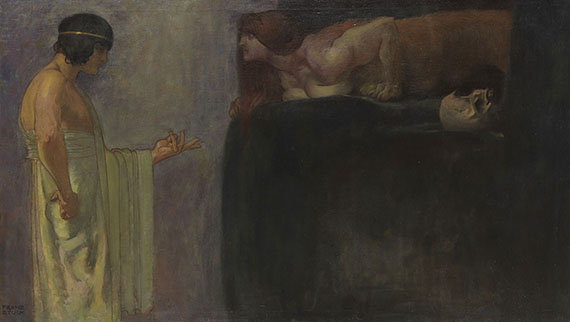Dictionary


Makart Style
Hans Makart (1840-84) is regarded as the main representative of Austrian historical and monumental painting, his oeuvre following Neo-Baroque ideas. He was referred to as the "Malerfürst" (Prince of Painters) not only because of his achievements as a painter, but for his eccentric and pompous lifestyle. In this regard his studio and apartment were decisive, as they were paid for by public expenses after he had been appointed to the academy in 1869. Makart furnished the rooms himself: antiquities and treasures from all over the world, such as carpets, suits of armor, furs and arms, as well as luscious arrangements of plants made his studio a work of art, it was open to visitors, like a museum, for one hour every day. He also threw wild artist parties. Based on this exuberant decoration, the so-called Makart style developed in Austria in the last third of the 19th century, having strong impact on interior design in both Germany and Austria. The "Makart-Bouquet", a bundle of artificial or dried flowers, partly colored or with gold and feathers or leaves, which came to full effect in combination with dark wooden pieces of furniture in Neo-Renaissance style. A second highlight of Makart's interior design was the study of Nikolaus Dumba, which the artist worked on in 1871 and 1872. He employed ceilings and murals, dark wooden paneling and bulky, richly decorated furniture, making the room a work of art in its own right.
Hans Makart (1840-84) is regarded as the main representative of Austrian historical and monumental painting, his oeuvre following Neo-Baroque ideas. He was referred to as the "Malerfürst" (Prince of Painters) not only because of his achievements as a painter, but for his eccentric and pompous lifestyle. In this regard his studio and apartment were decisive, as they were paid for by public expenses after he had been appointed to the academy in 1869. Makart furnished the rooms himself: antiquities and treasures from all over the world, such as carpets, suits of armor, furs and arms, as well as luscious arrangements of plants made his studio a work of art, it was open to visitors, like a museum, for one hour every day. He also threw wild artist parties. Based on this exuberant decoration, the so-called Makart style developed in Austria in the last third of the 19th century, having strong impact on interior design in both Germany and Austria. The "Makart-Bouquet", a bundle of artificial or dried flowers, partly colored or with gold and feathers or leaves, which came to full effect in combination with dark wooden pieces of furniture in Neo-Renaissance style. A second highlight of Makart's interior design was the study of Nikolaus Dumba, which the artist worked on in 1871 and 1872. He employed ceilings and murals, dark wooden paneling and bulky, richly decorated furniture, making the room a work of art in its own right.
Offers
Headquarters
Joseph-Wild-Str. 18
81829 Munich
Phone: +49 89 55 244-0
Fax: +49 89 55 244-177
info@kettererkunst.de
Louisa von Saucken / Undine Schleifer
Holstenwall 5
20355 Hamburg
Phone: +49 40 37 49 61-0
Fax: +49 40 37 49 61-66
infohamburg@kettererkunst.de
Dr. Simone Wiechers / Nane Schlage
Fasanenstr. 70
10719 Berlin
Phone: +49 30 88 67 53-63
Fax: +49 30 88 67 56-43
infoberlin@kettererkunst.de
Cordula Lichtenberg
Gertrudenstraße 24-28
50667 Cologne
Phone: +49 221 510 908-15
infokoeln@kettererkunst.de
Hessen
Rhineland-Palatinate
Miriam Heß
Phone: +49 62 21 58 80-038
Fax: +49 62 21 58 80-595
infoheidelberg@kettererkunst.de
We will inform you in time.




